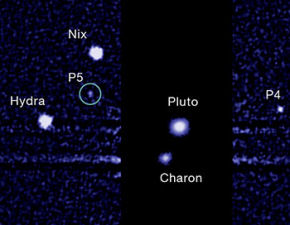12 July 2012
New moon discovery adds to Pluto's mystery
by Will Parker
 The Hubble Space Telescope has uncovered a fifth moon - dubbed P5 - orbiting the icy dwarf planet Pluto. The new-found moon, visible as a speck of light in Hubble images, is irregular in shape and estimated to be between 10-25 kilometres across. It is in a 95,000 kilometre-diameter circular orbit around Pluto and is believed to lie in the same orbital plane as Pluto's other known moons.
The Hubble Space Telescope has uncovered a fifth moon - dubbed P5 - orbiting the icy dwarf planet Pluto. The new-found moon, visible as a speck of light in Hubble images, is irregular in shape and estimated to be between 10-25 kilometres across. It is in a 95,000 kilometre-diameter circular orbit around Pluto and is believed to lie in the same orbital plane as Pluto's other known moons.
Pluto's largest moon, Charon, was discovered in 1978. Hubble observations in 2006 uncovered two additional small moons, Nix and Hydra. In 2011 another moon, known as P4, was found in Hubble data.
"The moons form a series of neatly nested orbits, a bit like Russian dolls," mused SETI Institute's Mark Showalter, who led the team that found the moon. The discovery adds to the intrigue that such a tiny planet can have such a complex collection of satellites. The favored theory explaining Pluto's numerous companions is that the moons are relics of a collision between Pluto and another large Kuiper belt object billions of years ago.
The new discovery will help scientists plot a safe path for NASA's New Horizons spacecraft through the Pluto system in 2015, when it makes an historic and long-awaited high-speed flyby of the distant world. It will return the first ever detailed images of the Pluto system, which is so small and distant that even Hubble can barely see the largest features on its surface.
"The discovery of so many small moons indirectly tells us that there must be lots of small particles lurking unseen in the Pluto system," said Harold Weaver, of Johns Hopkins University and New Horizons team member.
The team are using Hubble's powerful vision to scour the Pluto system to uncover potential hazards to the New Horizons spacecraft. "The inventory of the Pluto system we're taking now with Hubble will help the New Horizons team design a safer trajectory for the spacecraft," said Alan Stern of the Southwest Research Institute, the mission's principal investigator.
Related:
Discuss this article in our forum
Astronomers Get Gnarly Over Planetary Definitions
Rewriting The Cosmic Rulebook
Radioastronomers Measure Sizes Of Distant Planets
Lost: one giant planet
Source: NASA, ESA
